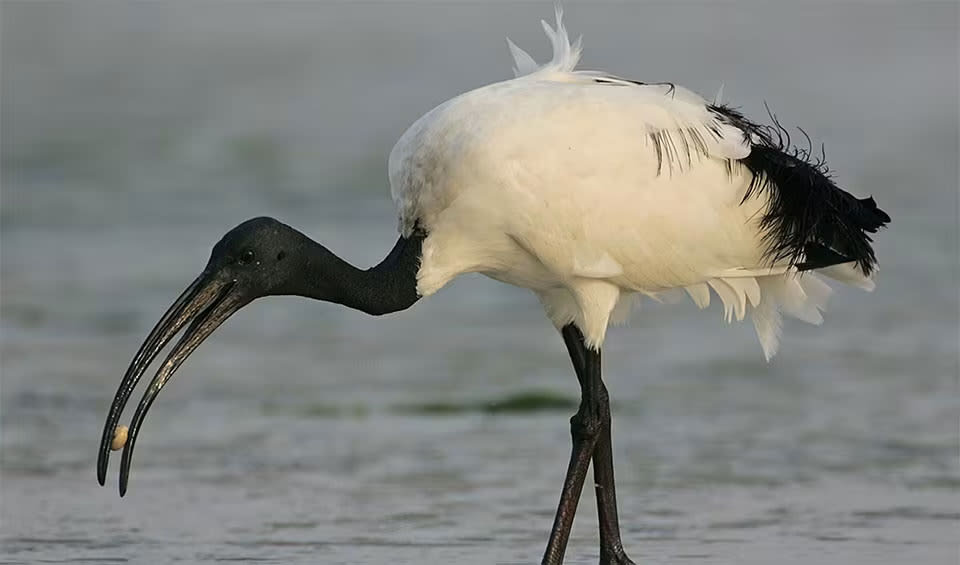A species steeped in history and mythology, particularly within the context of ancient Egypt, where it was venerated and often associated with Thoth, the deity of wisdom and writing. Despite its sacred status in ancient times, this reverence led to mass exploitation, where countless ibises were mummified and offered as votive sacrifices.
Beyond its historical significance, the African Sacred Ibis is a visually striking bird with a contrasting plumage of gleaming white body feathers and black wing and tail feathers. Its long, down-curved, black bill is not just a symbol of beauty but a highly effective tool for foraging in its preferred habitats of marshy wetlands, mudflats, and the shores of lakes and rivers. It uses this bill to probe into the substrate, searching for a diet that includes various insects, small fish, amphibians, crustaceans, and other small creatures.
This species of ibis nests in large colonies, often alongside other waterbirds. Their nests are typically constructed from a collection of sticks and placed in trees or bushes, sometimes even on buildings and other structures. Their breeding grounds are characterized by a cacophony of sound, with their distinctive croaking calls resonating through the air.
Today, the African Sacred Ibis is no longer found in Egypt, with its population in its native habitats across Sub-Saharan Africa facing various threats, including habitat destruction and degradation. Their range has expanded beyond its historical confines due to both intentional and accidental introductions in various parts of the world, including Europe, where they have established feral populations.
Distribution
 Angola
Angola Azerbaijan
Azerbaijan Bahrain
Bahrain Benin
Benin Botswana
Botswana Burkina Faso
Burkina Faso Burundi
Burundi Cameroon
Cameroon Central Af. Rep.
Central Af. Rep. Chad
Chad Comoros
Comoros Congo-Brazzaville
Congo-Brazzaville Côte D’ivoire
Côte D’ivoire DR Congo (Kinshasa)
DR Congo (Kinshasa) Djibouti
Djibouti Egypt
Egypt Official estimate
Official estimate
 Equatorial Guinea
Equatorial Guinea Eritrea
Eritrea Eswatini
Eswatini Ethiopia
Ethiopia France
France Gabon
Gabon Gambia
Gambia Ghana
Ghana Guinea-Bissau
Guinea-Bissau Guinea
Guinea Iran
Iran Iraq
Iraq Kazakhstan
Kazakhstan Kenya
Kenya Kuwait
Kuwait Lesotho
Lesotho Malawi
Malawi Mali
Mali Mauritania
Mauritania Mozambique
Mozambique Namibia
Namibia Niger
Niger Nigeria
Nigeria Oman
Oman Rwanda
Rwanda Saudi Arabia
Saudi Arabia Senegal
Senegal Sierra Leone
Sierra Leone Somalia
Somalia South Africa
South Africa South Sudan
South Sudan Spain
Spain Sudan
Sudan Tanzania
Tanzania Togo
Togo Uganda
Uganda Yemen
Yemen Zambia
Zambia Zimbabwe
ZimbabweAnything we've missed?
Help us improve this page by suggesting edits. Glory never dies!
Suggest an editGet to know me
Terrestrial / Aquatic
Altricial / Precocial
Polygamous / Monogamous
Dimorphic (size) / Monomorphic
Active: Diurnal / Nocturnal
Social behavior: Solitary / Pack / Herd / Flock
Diet: Carnivore / Herbivore / Omnivore / Piscivorous / Insectivore
Migratory: Yes / No
Domesticated: Yes / No
Dangerous: Yes / No
African sacred ibis on banknotes






